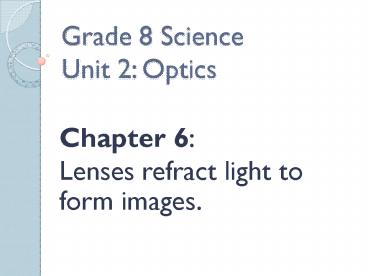Grade 8 Science Unit 2: Optics - PowerPoint PPT Presentation
1 / 35
Title:
Grade 8 Science Unit 2: Optics
Description:
Lenses There are two types of lenses: ... Fibre Optics Fibre Cable Optical Technologies ... Telescopes The objective lens has a longer focal length than the ... – PowerPoint PPT presentation
Number of Views:886
Avg rating:3.0/5.0
Title: Grade 8 Science Unit 2: Optics
1
Grade 8 ScienceUnit 2 Optics
- Chapter 6
- Lenses refract light to form images.
2
Lenses
- A curved piece of transparent material that
refracts light in a predictable way. - Usually made from glass or plastic.
3
Lenses
4
- There are two types of lenses
- 1. Convex
- Centre of the lens bulges out
- Causes light rays to bend toward each other
(converge)
5
- 2. Concave
- Centre of the lens is curved in
- Causes light rays to bend away from each other
(diverge)
6
Convex vs. Concave Lenses
7
Convex Lenses
- Can act as a magnifying glass
- Each lens has its own focal length (the distance
from the centre of the lens to the focal point)
8
- The greater the curvature of the lens, the
shorter the focal length. (pg. 217)
9
- Lenses have focal points on either side because
light shines through either side. - The line through the centre of the lens is called
the principle axis. - Optical centre is where the principle axis meets
the lens centre.
10
Optical Centre
Principle Axis
11
Concave Lenses
- To find the focal point, you must extend the
refracted rays back.
12
- Lenses with the greater curvature have the
shortest focal length. (pg. 221)
13
Corrective Lenses
The Eye (pg. 229)
14
Vision
15
Near-sighted Vision
- See objects up close but not at a distance.
- Concave lenses are used to correct this vision.
16
Near- sighted Vision
17
Far-sighted Vision
- See objects at a distance but not up close.
- Convex lenses are used to correct this vision.
18
Far-sighted Vision
19
- You must include the following incident rays
- Travelling parallel to the p.a.
- Travelling through the o.c.
- Travelling through the F.
Determining Focal Length...
20
Ray Diagrams Convex Lenses
- Object between the lens and focal point.
21
- Object is between the focal point and 2X the
focal length.
22
- Object is more than 2X the focal length.
23
Ray Diagrams Concave Lenses
The above is true for an object in all positions.
24
CORESTSEFibre Optics
- Fibre Cable
25
Optical Technologies...
- 1. Microscopes
- Uses two convex lenses with relatively short
focal points to magnify - Magnified twice to increase enlargement
26
The Microscope
27
- 2. Telescopes
- The objective lens has a longer focal length than
the microscope. - Can have either a refracting or reflecting
telescope
28
Refracting Telescope (pg. 245)
- The lenses bend light to focus it.
- The objective lens must be as large as possible
to view distant galaxies (makes it heavy)
29
Reflecting Telescope (pg. 246)
- Uses a concave mirror, plane mirror and a convex
lens to collect and focus light from objects at a
great distance. - Most large telescopes are this type.
30
- The Hubble Space Telescope
Launched in 1990
31
(No Transcript)
32
- 3. Cameras (pg. 248)
- 4. Binoculars (pg. 247)
- 5. Face shields
- 6. Magnifying glasses
- 7. Contact lenses
- 8. Flashlights
- 9. Eye glasses
33
The Nature of Science
- The development of new technologies involve many
individuals and groups of people. - These technologies can alter what we know about
the nature of science.
34
Individuals...
Galileo
Newton
35
Groups...































